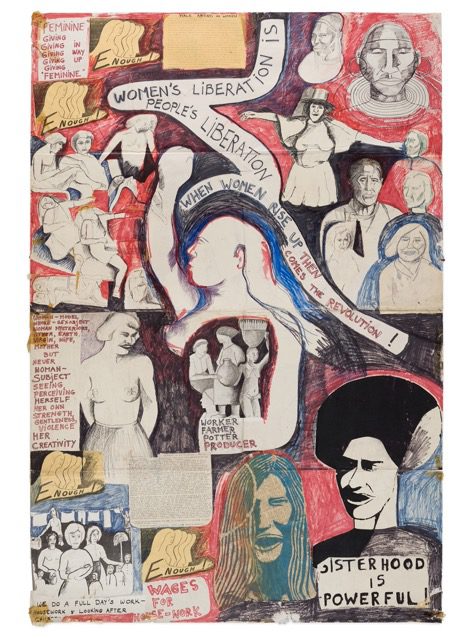
Monica Sjöö was an unwavering advocate for freedom from oppression in all its forms. Her works were made to be in this world as agents for change – political and spiritual. In this series, The Story of Monica Sjöö, discover how her personal, political and spiritual life intertwined to influence her artistic and activist practice. Read her biography below.
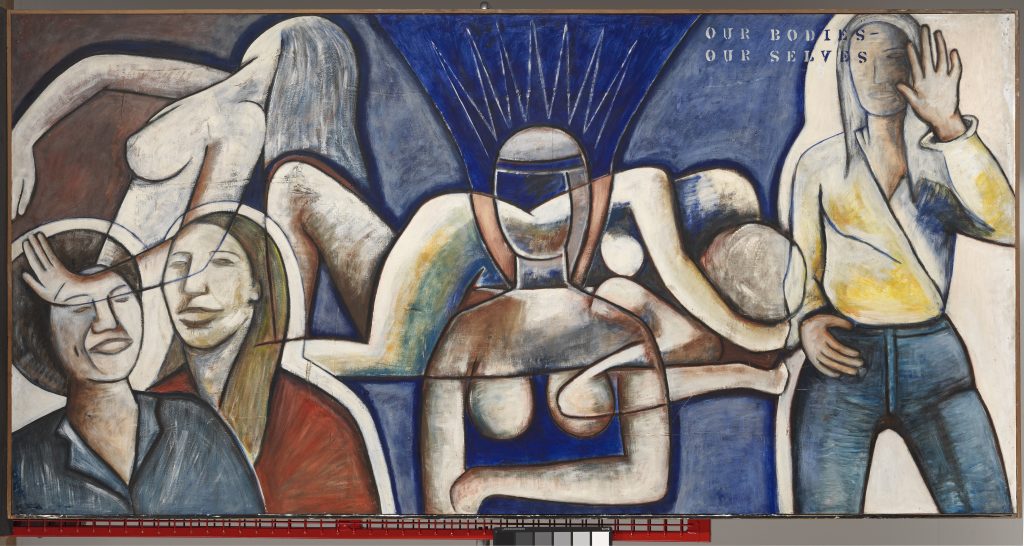
1938 – Monica Sjöö is born in Härnösand, the daughter of Gustav Sjöö and Harriet Rosander, both professional artists.
1941 – Sjöö’s parents divorce when she is just three years old.
1946 – At the age of eight, Sjöö moves to Stockholm with her mother. Her mother’s artistic career is not as successful as her father’s. Sjöö’s later approach to art, feminism, and politics is impacted by witnessing her mother’s grief over having to neglect her artistic career because of her dire financial difficulties and her struggles to make time for her work.
1954 – Sjöö reads The Origin of the Family, Private Property and the State (1884) which comes to influence her immensely.
1956 – At the age of sixteen, Sjöö drops out of school and runs away from home. She stays in Gothenburg for a brief period, where she makes a living as a life model for different art schools, including Valand Academy. She soon leaves Sweden and goes to Paris, where she meets her future husband, the Englishman Stevan Trickey.
1957 – Sjöö moves to Bristol with Trickey.
1958 – The couple spends the first months of the year in St. Ives, Cornwall, where they rent a studio and Sjöö starts painting. In the autumn she becomes pregnant.
1959 – Sjöö and Stevan Trickey leave Bristol and travel to Sweden. The couple are not registered in England since Trickey is evading National Service. They marry and stay in Sweden until 1961, when they return to Bristol. Sjöö gives birth to her first child, Sean, at a Swedish hospital.
Sjöö’s experience of medical intervention during labour has a strong impact on her negative view of hospital childbirth, which she later came to process and question in her work.
1961 – Sjöö and Trickey’s second son, Toivo, is born. This time it is a home birth, as planned. The experience changes her views on childbirth, female empowerment, and spirituality.
Sjöö attends classes in sculpture and etching, she paints, and helps Trickey – who is a silversmith – make jewellery.
1962 – Sjöö attends an art course at the Royal West of England Academy (RWA) in Bristol
1963 – Sjöö continues attending courses at the RWA. She reads Robert Graves’s book The White Goddess (1948).
1964 – Sjöö has her first exhibition in Bristol. The exhibition consists primarily of abstract paintings.
She is accepted into the Bristol Old Vic Theatre School to study theatre design, where she encounters the plays of Bertolt Brecht, ancient Greek dramas such as Oedipus Rex, and the Jacobean tragedy The Duchess of Amalfi.
1965 – Sjöö’s mother Harriet Rosander dies in September. Sjöö travels from Bristol to Stockholm with her son Toivo and decides to stay. During this time, Sjöö becomes involved in the anti-Vietnam War movement, organising exhibitions aimed at educating and spreading the word on American imperialism. She also helps raise funds for the National Liberation Front (NLF), among others.
Sjöö reads Alarm Clock (1941) by Elin Wägner, a writer, feminist, and forerunner of the so-called ‘green wave’ movement of the 1960s (which saw Swedes moving back to a more rural life) and the feminist ecological activism of the 1970s.
In the autumn, Sjöö meets the Swedish artist Siri Derkert.
1966 – Sjöö works briefly as an assistant set designer at Pistolteatern in Stockholm.
After several visits to Siri Derkert’s studio on Lidingö, Sjöö starts working as her assistant. Sjöö admires Derkert’s artistic practice and political activism, particularly when it comes to issues of equality and women’s rights. They stay in touch even after their professional relationship ends, exchanging letters up until Derkert’s death in 1973.
She continues to be active in the protest movement against America’s invasion of Vietnam.
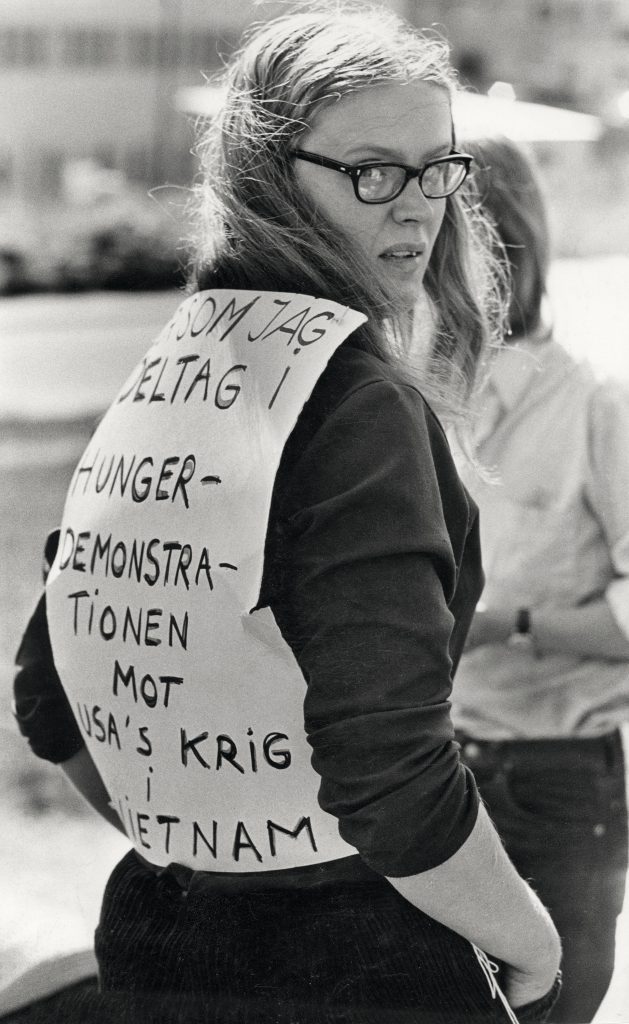
Sjöö travels to Italy with the anarchists Bengt Ericsson, Ingvar Salomonsson, and Lennart Karlsson to participate in an anarchist conference, but they are arrested and deported by the Italian police.
1967 – Sjöö has her first solo exhibition at Galleri Karlsson in Stockholm. Her paintings depict naked men, deliberately challenging the dominant male ideal within what Sjöö considers androcentric art history. The motifs are considered improper and had already the year before been retouched in an article for the Swedish magazine Se.
Later that year, Sjöö leaves Stockholm and returns to Bristol.
1968 – Sjöö paints one of her best-known works, God Giving Birth. The painting is inspired by her experience of giving birth to her second child at home.
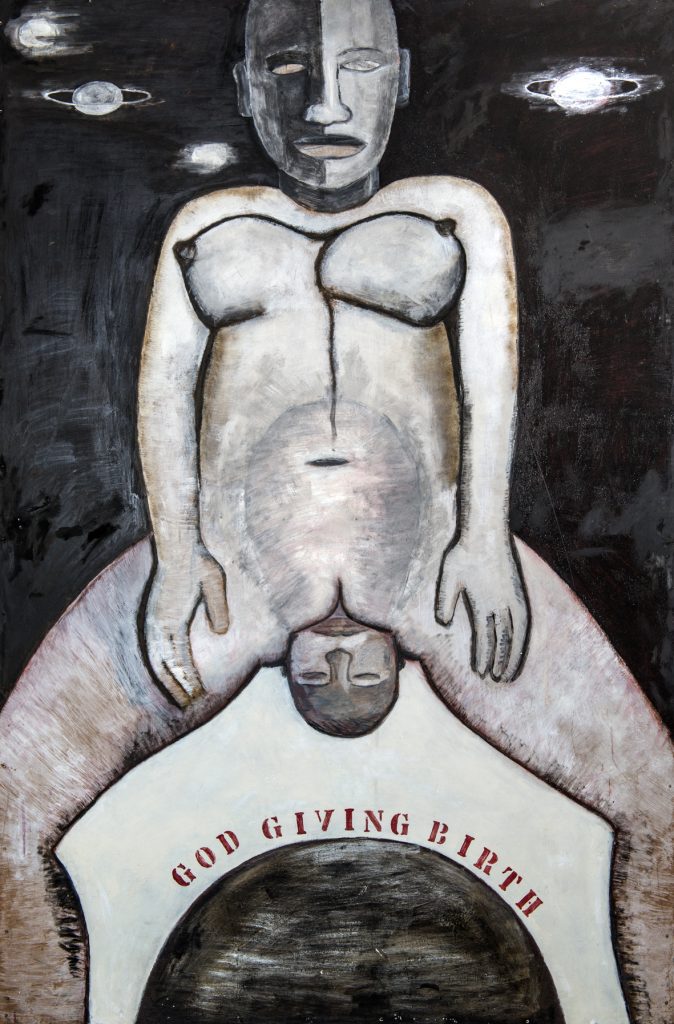
In England she gets to know several members of the radical group King Mob. Formed in the 1960s by the brothers David and Stuart Wise, the King Mob members called themselves ‘the gangsters of the new freedom’. They combined sharp politics with Dadaism’s disruptive potential in their confrontational happenings.
1969 – Sjöö’s father Gustav dies of cancer. She marries the pianist and composer Andrew Jubb.
Sjöö has a solo exhibition at Arts Lab in Drury Lane, London, where God Giving Birth is shown.
She paints Past and Present while living on Princess Victoria Street in Bristol. Sjöö joins several other women to form Bristol Women’s Liberation Group.
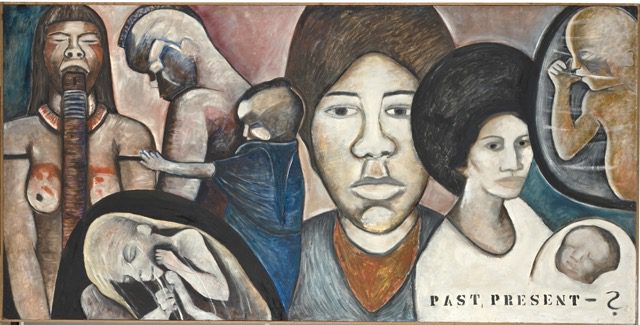
1970 – Gives birth to her third son, Leif.
Participates in the first National Women’s Liberation Conference in the UK at Ruskin College in Oxford. Sjöö tries to exhibit six of her paintings in conjunction with the St. Ives Festival, but the works are hastily removed by council officials.
She is invited to give a lecture on abortion rights at a conference in Liverpool. Shortly thereafter she founds the Women’s Abortion and Contraceptive Campaign (WACC) in Bristol.
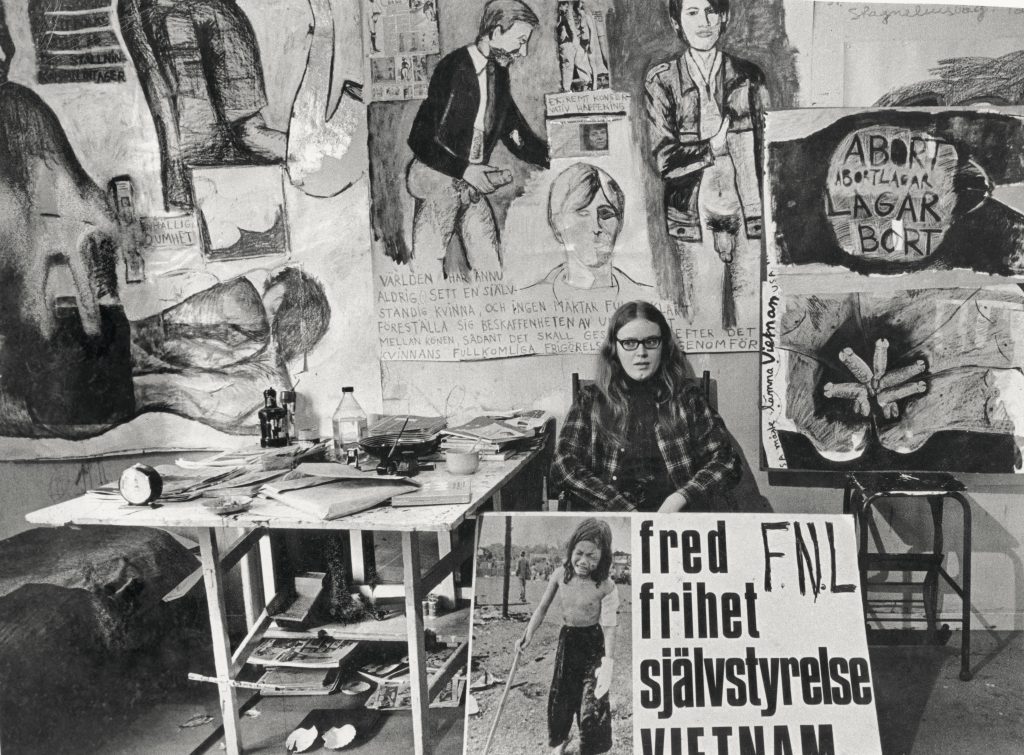
1970 – In March the first Women’s Liberation Art Group exhibition is presented at the Woodstock Gallery in London.
Sjöö and the artist Anne Berg write the Images on Womenpower – Arts Manifest. It raises questions about abstract art and how it is embedded in Western male privilege.
Paints Aspects of The Great Mother and Cosmos within Her Womb, inspired by a Neolithic grave from circa 10,000 years ago. Sjöö portrays the woman as the archetypal mother and a direct link to the origin of life.
Meets the American artist Carolee Schneemann. They keep in touch over subsequent years.
1972 – Sjöö writes the manifesto Towards a Revolutionary Feminist Art, which is rooted in a feminist critique of the Western, male-dominated art world and the lack of women in art history. The manifesto can be seen as a call to women to organise themselves.
She participates in the National Women’s Liberation Conference at Acton Town Hall in London.
1973 – The exhibition Images of Womanpower opens at the Swiss Cottage Library in Camden Town, London. The participating artists are Anne Berg, Liz Moore, Monica Sjöö, Beverly Skinner, and Roslyn Smythe.
The exhibition provokes strong reactions, and a complaint is filed against Sjöö’s painting God Giving Birth. She is consequently charged with blasphemy and pornography, but the charges are eventually dropped.
1974 – Sjöö publishes the pamphlet Some Notes on Feminist Art – Women’s Art, Women Culture Reborn. She presents some works in the exhibition Kvinnoliv [Women’s Lives] at Lunds Konsthall following an invitation from the Swedish artist Anna Sjödahl, who Sjöö met at the Swiss Cottage Library exhibition.
1975 – Sjöö publishes the pamphlet The Ancient Religion of The Great Cosmic Mother of All, which is the first draft of the book that she would later publish with Barbara Mor in 1981.
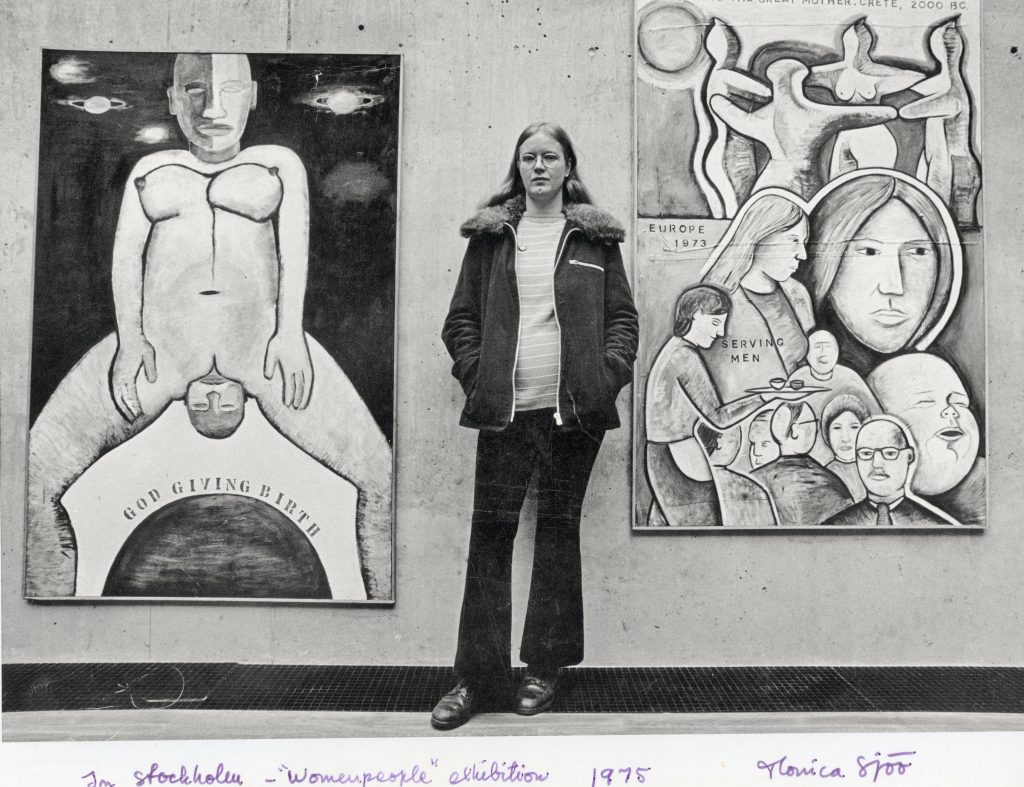
1976 – Sjöö contacts the quarterly magazine WomanSpirit and starts corresponding with writer and poet Barbara Mor. She publishes the article The Witches Are Returning in Peace News.
1977 – The pamphlet The Ancient Religion of The Great Cosmic Mother of All is translated into Norwegian and published as a book (Den Store Kosmiske Mor).
Jane Jackson produces the short documentary Portrait (Monica Sjöö) about the artist and her practice. The documentary is shown at the Institute of Contemporary Arts (ICA), London, and the London Film Festival.
1978 – Sjöö visits the Neolithic monument Silbury Hill in Avebury and has a profound spiritual experience there. After her visit she paints The Goddess at Avebury and Silbury. She also visits the Stone Age monuments at Newgrange in Ireland for the first time.
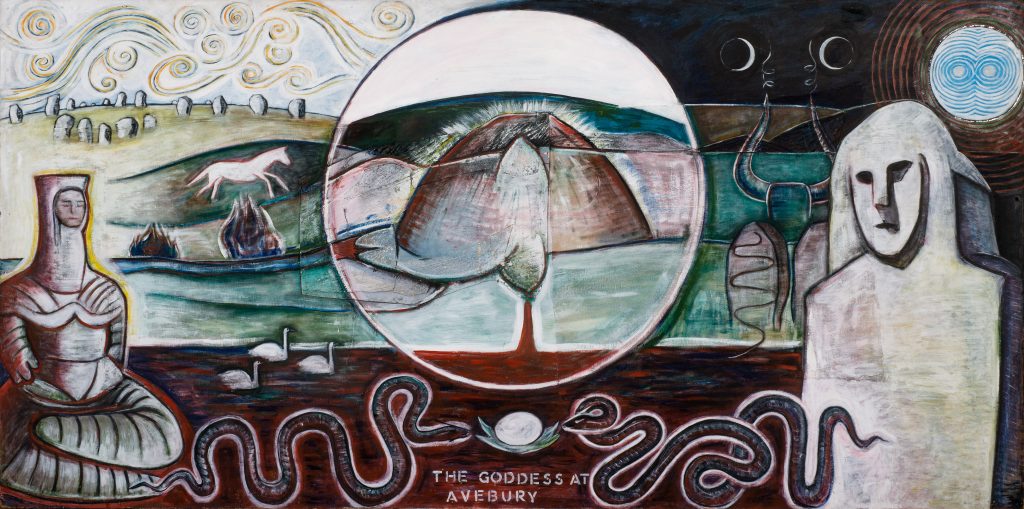
1980 – Sjöö and Anne Berg give a lecture at the first International Festival of Women Artists in Copenhagen.
1981 – Publishes the book The Ancient Religion of the Great Cosmic Mother of All with American writer and feminist Barbara Mor.
Participates in a protest march to the airfield RAF Brawdy organised by Welsh Anti-Nuclear Alliance (WANA). To protest the proposed placement of cruise missiles in the area, a group of women stage a march.
The Greenham Common protests start on 27 August 1981, when the Women for Life on Earth group embarks on a ten-day march from Cardiff to to Greenham Common air base in Berkshire, a distance of almost 200 kilometres. They set up what has come to be known as the Greenham Common Women’s Peace Camp.
1982 – The Women for Life on Earth march takes place on 4 June and involves the participation of over five hundred demonstrators walking from Fishguard to U.S. Brawdy’s submarine tracking station. Sjöö is one of the organisers, along with Ann Pettitt.
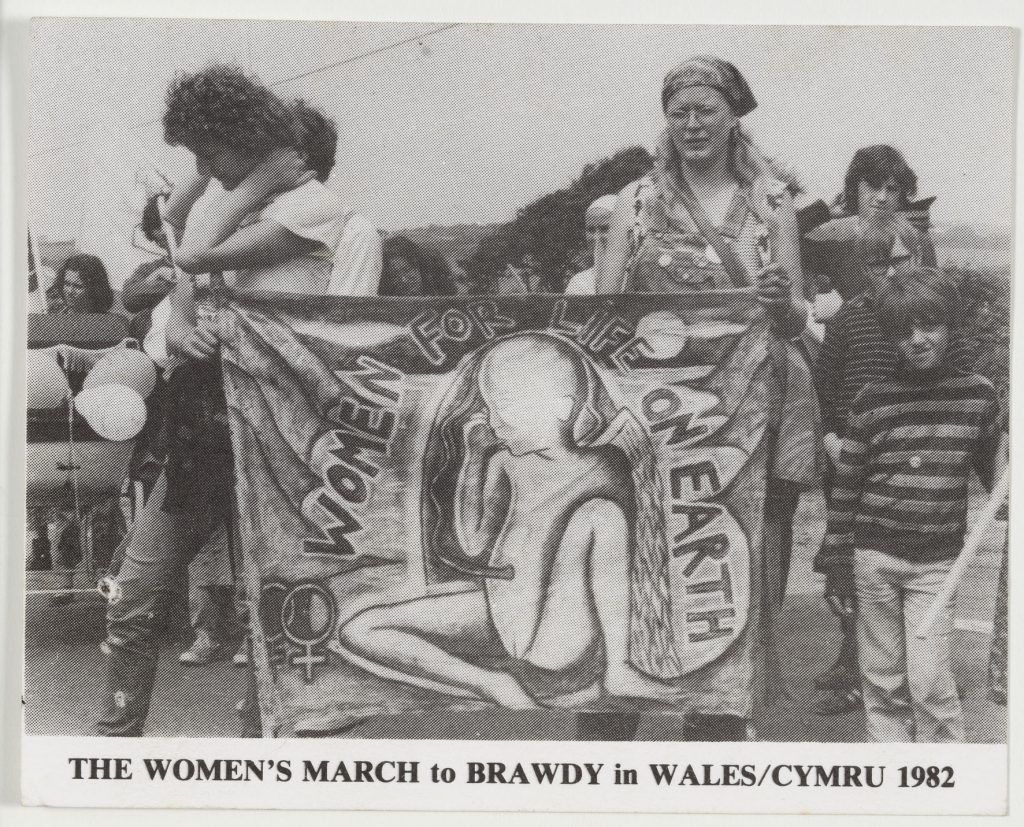
Sjöö travels to Greenham Common Women’s Peace Camp to participate in the protest Embrace the Base. She returns several times in the following two years.
1984 – Sjöö creates several new collages and paints The Earth is Our Mother and The Goddess in Her Manifestations at Greenham Common, among other works.
She completes the manuscript for Spiral Journey, a compilation of texts on her travels to sacred sites of the Celtic Britons.
1985 – Sjöö’s paintings are included in the exhibition Women Artists in Wales, which tours across Wales.
In August, Sjöö goes on holiday to the Pyrénées with her youngest son, Leif. While there, he is hit by a car. Thirty hours later Leif dies of his injuries, aged fifteen. The sudden death of her son has a profound effect on Sjöö, and she enters a state of mourning.
Shortly thereafter another tragedy occurs: her eldest son, Sean, is diagnosed with lymphoma.
1986 – Sjöö paints Lament for My Young Son, the first of a series of paintings dedicated to her son after his tragic death.
1987 – Publishes a further book with Barbara Mor, The Great Cosmic Mother: Rediscovering the Religion of the Earth, which becomes one of Sjöö’s best-known works.
Her son Sean dies of lymphoma.
1989 – Participates in the exhibition The Goddess Re-emerging at the Glastonbury Assembly Rooms along with the artists Jill Smith, Philippa Bowers, and Joanna Corner.
She reads Marija Gimbutas’s book Language of the Goddess, which influences her profoundly. Sjöö makes the acquaintance of poet, writer, and activist Alice Walker, and they become friends shortly thereafter.
1990 – Travels to the US again and exhibits at Gaia bookstore in Berkeley.
1993 – Sjöö completes several important paintings including Meeting the Ancestors at Avebury.
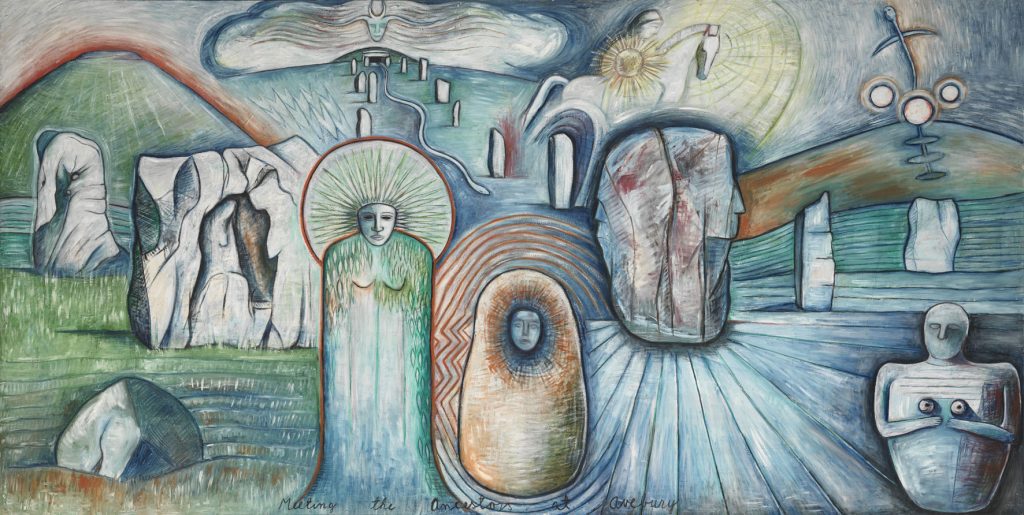
She and other women in the Ama Mawu group (which she co-founded) interrupt a service at Bristol Cathedral. Participates in the group exhibitions Women Made at Cooper’s Gallery in Bristol and Women Remember Women in Conflict in Liverpool.
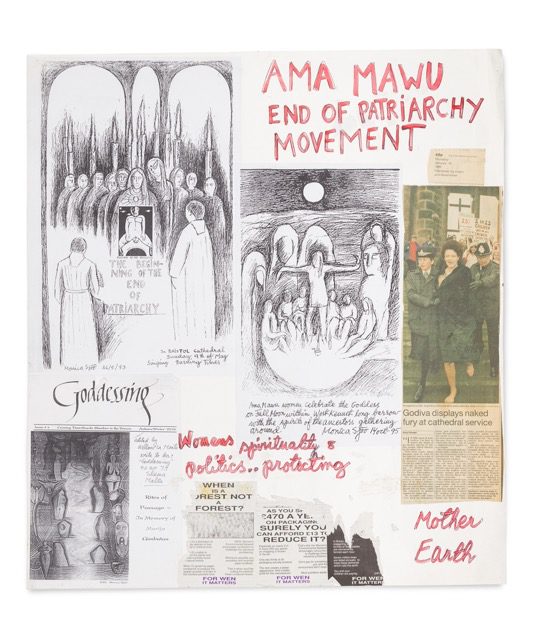
1994 – The archaeologist and author of The Living Goddesses, Marija Gimbutas, dies. Sjöö paints Rites of Passage and dedicates it to Gimbutas. Sjöö visits the first international goddess festival in California.
Museum Anna Nordlander in Skellefteå organises a solo exhibition with some thirty of Sjöö’s works, including God Giving Birth and Cosmos within Her Womb. In connection with the exhibition, the museum acquires several of her paintings.
1996. Sjöö visits the Newbury Bypass protest in Berkshire, where eco-activists are ‘tree-sitting’ to halt the clearing of ancient woodland for a new motorway.
She creates several new works, including Mother Earth in Pain, Her Trees Cut Down, Her Sea Polluted.
The first goddess conference takes place in Glastonbury Goddess Temple. Several of Sjöö’s paintings are installed on the walls of the Assembly Rooms.
1997 – Sjöö participates in the Sharjah Third International Biennial, United Arab Emirates.
She is diagnosed with breast cancer.
1998 – Sjöö participates in the group show Hjärtat sitter till vänster – svensk konst [The Heart is on the Left: Swedish Art 1964–1974] at Gothenburg Museum of Art.
1999 – Writes her final book, The Norse Goddess, published the following year.
2001- Exhibits a selection of her paintings at the Create Centre Gallery in Bristol.
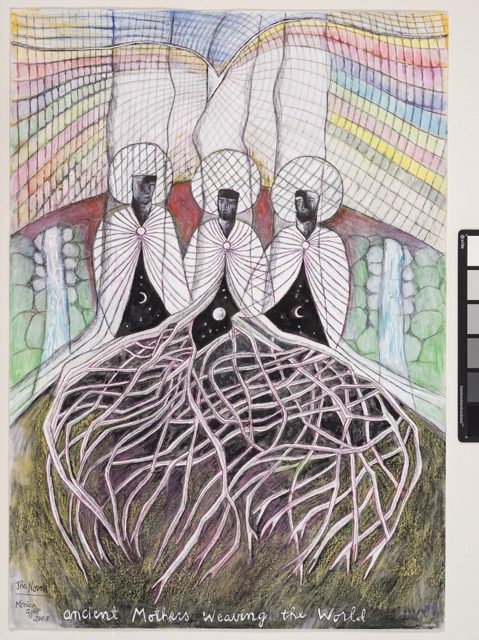
After several years of correspondence, Sjöö finally meets the American artist Judy Chicago in Cambridge.
2002 – Travels to Russia to participate in the group exhibition Windows to Other Worlds at Saint Petersburg State University.
Makes her last trip to the US to attend the Goddess Festival in La Honda, California.
2003 – Sjöö is diagnosed with secondary bone cancer and her right arm is operated on shortly thereafter.
2004 – Sjöö’s retrospective Through Time and Space: The Ancient Sisterhoods Spoke to Me opens at Hotbath Gallery in Bath. Alice Walker writes the foreword of the exhibition catalogue.
2005 – Monica Sjöö dies in Bristol on 8 August.
